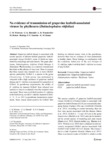Por favor, use este identificador para citar o enlazar este ítem:
http://www.alice.cnptia.embrapa.br/alice/handle/doc/1055139| Título: | No evidence of transmission of grapevine leafroll-associated viruses by phylloxera (Daktulosphaira vitifoliae). |
| Autor: | WISTROM, C. M.  BLAISDELL, G. K.   WUNDERLICH, L. R.   BOTTON, M.   ALMEIDA, R. P. P.   DAANE, K. M.   |
| Afiliación: | M. C. Wistrom, Department of Environmental Science, Policy and Management, University of California, Berkeley, CA 94720-3114, USA e-mail: kdaane@ucanr.edu; G. K. Blaisdell, Department of Environmental Science, Policy and Management, University of California, Berkeley, CA 94720-3114, USA e-mail: kdaane@ucanr.edu; L. R. Wunderlich, Central Sierra Region, University of California Cooperative Extension, Placerville, CA 95667, USA; MARCOS BOTTON, CNPUV; Rodrigo P. P. Almeida, Department of Environmental Science, Policy and Management, University of California, Berkeley, CA 94720-3114, USA; K. M. Daane, Department of Environmental Science, Policy and Management, University of California, Berkeley, CA 94720-3114, USA. |
| Año: | 2016 |
| Referencia: | European Journal of Plant Pathology, [online], 2016. |
| Descripción: | Grapevine leafroll disease is associated with several species of phloem-limited grapevine leafrollassociated viruses (GLRaV), some of which are transmitted by mealybugs and scale insects. The grape phylloxera, Daktulosphaira vitifoliae (Fitch) Biotype A (Hemiptera: Phylloxeridae), is a common vineyard pest that feeds on the phloem of vine roots. There is concern that these insects may transmit one or more GLRaV species, particularly GLRaV-2, a species in the genus Closterovirus. A field survey was performed in vineyards with a high incidence of grapevine leafroll disease and D. vitifoliae was assessed for acquisition of GLRaV. In greenhouse experiments, the ability of D. vitifoliae to transmit GLRaV from infected root sections or vines to co-planted virus-free recipient vines was tested. There were no GLRaV-positive D. vitifoliae in the field survey, nor did D. vitifoliae transmit GLRaV- 1, ?2, ?3, or -4LV in greenhouse transmission experiments. Some insects tested positive for GLRaV after feeding on infected source vines in the greenhouse, however there was no evidence of virus transmission to healthy plants. These findings, in combination with the sedentary behaviour of the soil biotype of D. vitifoliae, make it unlikely that D. vitifoliae is a vector of any GLRaV. |
| Thesagro: | Uva Doenca de planta Virus Praga de planta Cochonilha Inseto |
| NAL Thesaurus: | Phylloxera Daktulosphaira vitifoliae Grapevine leafroll-associated virus Closteroviridae |
| Palabras clave: | Grapevine leafroll disease Videira |
| DOI: | 10.1007/s10658-016-1049-9 |
| Notas: | DOI: 10.1007/s10658-016-1049-9 |
| Tipo de Material: | Artigo de periódico |
| Acceso: | openAccess |
| Aparece en las colecciones: | Artigo em periódico indexado (CNPUV)  |
Ficheros en este ítem:
| Fichero | Descripción | Tamaño | Formato | |
|---|---|---|---|---|
| Bottonart3A10.10072Fs1065801610499.pdf | 265.02 kB | Adobe PDF |  Visualizar/Abrir |









